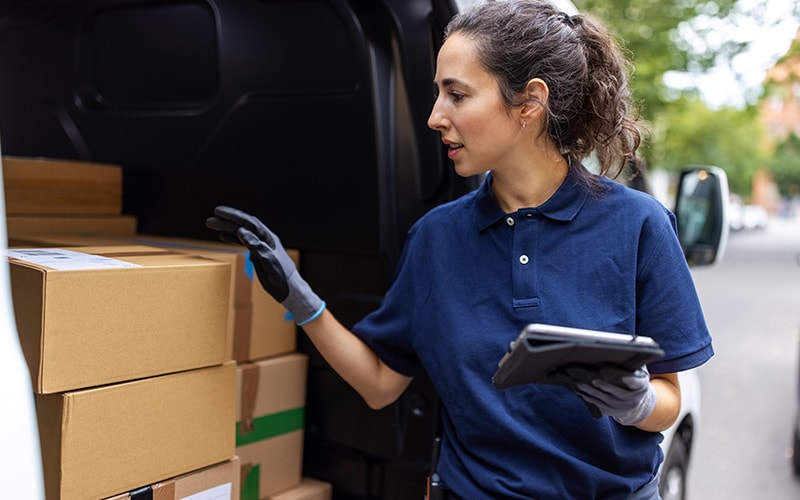
Insights
- Speedy last-mile deliveries can be a differentiator for logistics companies.
- However, implementation of last-mile delivery is cost-intensive.
- Using AI can help companies streamline their operations, improve customer experience, and reduce costs related to last-mile deliveries.
- Successful AI implementation requires data readiness, artificial intelligence (AI) talent, training processes, and a governance task force to ensure ethical AI.
Consumer expectations for same-day and next-day deliveries are high. For online purchases across categories in 2024, almost two-thirds of global shoppers expected to receive their items within 24 hours. Logistics companies can rise to these expectations by using AI to identify cost savings and improve efficiency.
Reasons for widespread appeal
For almost 96% of consumers, delivery speed is a deciding factor in their online purchases, and 61% end up forgoing a purchase because of slow shipping times. Customers are willing to pay a premium for quicker delivery and won’t hesitate to move to other brands if they are dissatisfied. Speed of delivery is thus a key driver of strategy for brands as they seek to boost customer satisfaction and brand loyalty.
Cost factor for brands
However, speedy last-mile deliveries are cost-intensive for logistics companies. Last-mile and speedy deliveries make for nearly 53% of total shipping costs in B2C supply chains. Failed domestic deliveries cost retailers an average of $17.20 per order or $197,730 per year, as seen in a study of consumers across the US, UK, and Germany. This is because the traditional last-mile delivery model comes with challenges, including the high costs of fuel consumption, static route planning with predetermined routes, and lack of real-time data analysis, which results in inefficiencies such as choice of routes with traffic congestion, leading to unpredictable delays that impact estimated time of arrivals. Delivery allocation conducted without real-time data increases failed attempts, which also elevates costs and can impact customer satisfaction.
Unsurprisingly, 85% of retail executives said decreasing their total cost per order is the biggest priority for last-mile delivery.

How AI can help
Research has shown that retailers who employ AI-driven solutions to personalize their offerings experience higher engagement and conversion rates. Companies that integrate AI in their logistics, supply chains, and marketing grow three times faster than their competitors. Successfully implementing AI-enabled supply-chain management has helped early adopters improve their logistics costs by 15%.
AI pulls in information from multiple sources such as GPS, traffic databases, and meteorological data. It processes large data sets to recalibrate routes in real time, based on traffic, weather, roadblocks, and delivery time windows. FedEx uses predictive models to analyze internal and external data points to streamline delivery routes and track packages. Predictive analytics are also used for demand forecasting and fleet scaling. Smart fleet allocation helps assign orders to optimal vehicles and drivers. Reduction in empty miles leads to lower costs and emissions. DHL uses AI to minimize unnecessary stops and extra trips, directly reducing fuel consumption.
Companies can plan personalized delivery experiences using AI insights. The real time data aspect of AI also enables better co-operation and coordination between courier companies and vendors, seamless information sharing between backend and frontend systems, and continuous communication with end consumers, helping provide better customer service and scalable solutions to meet growing delivery demands.
DHL also uses AI-powered forecasting models to analyze individual consignments, feeding data into Wise Systems’ AI-driven software to determine the most efficient delivery routes. The system considers all key variables to optimize sequencing and continuously refines estimated delivery times as the vehicle approaches its destination. Customers can adjust delivery time or location up until the last moment, improving convenience and first-attempt delivery success.
That said, Infosys research shows nearly 19% of logistics and supply chain companies surveyed have not started any generative AI initiatives. However, 25% believe that generative AI will have a positive impact on operational efficiency and automation.
Figure 1. Only 39% companies have implemented or are implementing generative AI solutions
Source: Infosys Knowledge Institute
Figure 2. User experience and personalization are areas where a positive impact is most expected
Source: Infosys Knowledge Institute
Successful AI for speedy last-mile deliveries
To get the best out of AI, logistics companies should take a structured approach to optimizing last-mile operations:
Conduct a data readiness assessment: Since AI relies on organizational data to analyze and predict efficiencies, companies must ensure their data meets key standards — covering storage, sources, and quality. They should assess their data for diversity, timeliness, accuracy, sufficiency, and availability in the right format to maximize AI’s effectiveness.
Set up an AI governance task force: Given the sensitive nature of logistics data, companies must also prioritize security and ethical AI use. Establishing a centralized AI governance task force can help oversee data integrity, compliance, and responsible AI implementation.

Train employees in use of AI technology: Companies need to identify the skills gaps and upskill employees who will be using the AI. Employees should be trained in working with telematics platforms that combine GPS tracking, sensors, and AI-driven software to manage driver and fleet operations, tools related to route optimization, and voice commands for order lookups and task updates. Organizations should also look at hiring new skills or expertise, wherever required. Infosys research shows that up to 18 percentage points can be added to the chance of AI success if a company has fully established change management AI training processes, and involves employees in decision-making about AI.
Invest in a single-platform last-mile delivery solution: This will help logistics companies to streamline processes with agentic workflows, consolidated data for contextual decision-making, and built-in scalability. By adopting a modern last-mile platform, organizations can reduce delivery costs and enhance consumer delivery experiences to create a competitive advantage in the marketplace. With rising competition in the parcel delivery service industry, a Fortune 50 global logistics company was seeking to transform itself from a point-to-point delivery service to a data-driven delivery organization. Infosys Consulting helped the client use AI and machine learning to improve the accuracy of delivery-date predictions, building a data platform for global delivery predictions. Infosys Consulting deployed a new architecture to operate at higher throughput speeds, which is process more data with lower latency. This led to the ability to make faster delivery-date predictions, and the end-to-end average latency improving to one minute from between 15 and 17 minutes, with 99% processed in close to two minutes.
Infosys Consulting helped the client use AI and machine learning to improve the accuracy of delivery-date predictions, building a data platform for global delivery predictions.
Prioritize use cases based on business impact: As part of a detailed change management plan, companies should identify which use cases they need AI for the most and their viability and start with targeted pilot programs to test the waters and make required adjustments. This will help reduce costs related to failed implementations or the instances of use cases that don’t have enough business value. Logistics companies also need to have a clear vision of their goals – be it reducing fuel consumption or carbon emissions, or streamlining their warehouse processes – and what success looks like, to implement the right AI solutions.
Build cross-functional teams: Since deliveries require coordination between multiple teams, companies should establish cross-functional teams where all members have a unified view of the deliveries and can make any decisions required of them seamlessly and effortlessly.
Plan for continuous evolution: With AI technology evolving constantly and customer needs undergoing shifts, organizations should keep an eye on the latest trends and be up-to-date with the tech, review it from time to time, explore new data sources, and be aligned with what the consumer wants, to use the AI to meet their demands most effectively.
By following these measures, logistics companies can successfully implement AI to streamline last-mile deliveries, reducing costs and improving customer satisfaction while minimizing associated challenges.







